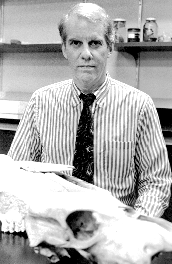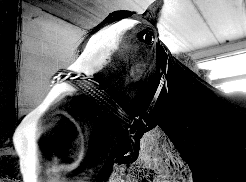
News Release
|
Office of News and Information Johns Hopkins University 3400 N. Charles Street Baltimore, Maryland 21218-2692 Phone: (410) 516-7160 / Fax (410) 516-5251 |
EMBARGOED FOR RELEASE SUNDAY, OCTOBER 19, 1997 CONTACT: Emil Venere Emil@jhu.edu |
Clues to Horse Extinctions Point to Gritty Grass, Changing Climate
 Johns Hopkins paleobiologist Steven Stanley
has sleuthed out clues to the evolution of horses,
coming up with a new solution for an enduring mystery: What
caused the extinction of many
equine species and other mammals 6 million years ago?
Johns Hopkins paleobiologist Steven Stanley
has sleuthed out clues to the evolution of horses,
coming up with a new solution for an enduring mystery: What
caused the extinction of many
equine species and other mammals 6 million years ago?Like the protagonist in an evolutionary detective thriller, Stanley pursued a hunch that apparently had never occurred to other scientists. His long shot hit a bull's-eye, enabling Stanley to learn how shifting climate and changing vegetation likely altered the fate of horses in North America millions of years ago.
Stanley, a professor in the Johns Hopkins Department of Earth and Planetary Sciences, pieced together the findings of other scientists and connected those data in a way no other researchers had done previously. When taken together, the data paint a picture of how Earth's changing climate and vegetation may have been directly involved in the dramatic evolutionary trends of horses and other animals.
The time was marked by the largest extinction rate of North American mammals in the last 30 million years; about 60 genera, containing numerous species, perished.
Some scientists believe that changing atmospheric concentrations of carbon dioxide could have helped bring about the same climatic shifts that Stanley believes are directly linked to changes in the types of vegetation thriving in North America. Because the extinctions apparently were brought about by changing vegetation, global warming could have a profound impact on extinction rates; the warming results from increasing the amount of carbon dioxide in the atmosphere.
Stanley will touch on his theory during a 1:35 p.m. talk on Sunday, Oct. 19, at the start of the annual meeting of the Geological Society of America. The talk will be in the Salt Palace Convention Center, in Salt Lake City, Utah.
Contrary to the popular belief that horses were foreign to the New World until they were brought here by the Spaniards, the animals actually evolved in North America, spreading to Europe by crossing the Bering land bridge that once connected Alaska and Siberia. But they later died out in North America near the end of the Ice Age.
Well before their disappearance, however, their life history took an abrupt turn that killed off all but those horses with the longest teeth. In fact, numerous other mammals, including camels and rhinos, suffered the same fate in North America.
 Scientists have known that the extinctions were somehow related
to expanding grasslands and
shrinking forests. Grasses possess a gritty compound called
silica, which is contained in sand
and is used to make glass. As animals chew grass, the silica
wears down their teeth.
Therefore, animals with longer teeth live longer because their
teeth don't wear down as fast,
and they can continue to feed.
Scientists have known that the extinctions were somehow related
to expanding grasslands and
shrinking forests. Grasses possess a gritty compound called
silica, which is contained in sand
and is used to make glass. As animals chew grass, the silica
wears down their teeth.
Therefore, animals with longer teeth live longer because their
teeth don't wear down as fast,
and they can continue to feed.
For tens of millions of years, as the Earth's climate became cooler and dryer, the trend toward expanding grasslands and receding forests continued in North America. About 13 million years ago, the 15 or so species of horses in North America were split between those with long teeth and those with shorter teeth. Also at that time, a few new species emerged that had very long teeth.
As grasslands expanded, the horses with long teeth lived longer because they were best adapted to eating grasses instead of leaves. Living longer enabled them to produce enough offspring to guarantee survival of their species and the evolution of new species.
By 11 million years ago, only the horses especially adapted to eating grasses -- those with the long and very long teeth -- were living in North America.
"Then, there is this sudden event, 6 million years ago, more or less, and what you see is a big extinction pulse, a big drop in total diversity, and the survivors are all the ones with very long teeth," Stanley said.
The conventional wisdom has suggested that the long-toothed horses disappeared because of expanding grasses. But that just didn't make sense, Stanley said, because the horses with long teeth were especially adapted to eating grasses.
"So, why would more grass be a problem for them?" Stanley asked.
Somehow, something about the grasses must have changed, he reasoned.
Meanwhile, other scientists had discovered that, as the climate became dryer and cooler, a different type of grasses began to dominate North America. Those grasses, known as C4 grasses, which thrive in dryer climates, replaced many of the previously dominant grasses, known as C3 grasses.
"I thought, well, this seems like a long shot, but I wonder if there are on average more silica bodies in the C4 grasses than C3 grasses," Stanley said.
His hunch proved correct. Stanley found that, on average, C4 grasses contain about three times as many of the silica particles as do C3 grasses.
"Think about a species that was doing all right eating C3 grasses. Maybe it lived 10 years on average and produced enough colts to reproduce the species. Well, what happens if that horse is suddenly only living seven years, or six years? It may not produce enough colts to perpetuate its species.
"I think that's what happened. I think there was a big grind down."
The title of his talk is, "Geobiology: Studying the deep history of the earth-life system."
|
Johns Hopkins University news releases can be found on the
World Wide Web at
http://www.jhu.edu/news_info/news/ Information on automatic e-mail delivery of science and medical news releases is available at the same address.
|
 Go to
Headlines@HopkinsHome Page
Go to
Headlines@HopkinsHome Page